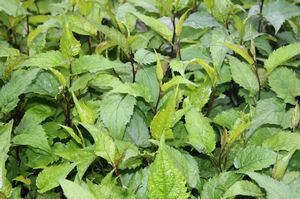Printed at http://www.newmoonnursery.com/index.cfm/
Aster divaricatus 'Eastern Star'
White wood aster
Native to North America (cultivar)
FIRST IMPRESSIONS: Aster divaricatus ‘Eastern Star’ is a low mounding perennial with glossy heart shaped or oval leaves. In late summer starry white daisies cover the plant and gleam in the shade. Plants are tough and adaptable prospering in part shade or shade and in dry or moist soils. This cultivar is more compact than the species with dark glossy stems.
HABITAT & HARDINESS: Aster divaricatus ‘Eastern Star’ was found in a native population in coastal Rhode Island by Roger Rache. Nursery plants were first grown in California’s Canyon Creek Nursery and later in in North Creek Nursery.
Hardy from USDA Zones 3-8.
PLANT DESCRIPTION: Aster divaricatus ‘Eastern Star’ is a mounding or softly sprawling perennial. Plants form dense colonies from underground rhizomes and tend to self-seed.
Heart shaped leaves occur at ground level and smaller ovate leaves are arranged along the black wiry stems.
Flat topped branched flower clusters are produced from late summer until mid-fall. The fragrant flower heads are composed of a ring of white petal-like ray flowers surrounding a central cluster of yellow or rose colored disc flowers. The heads are produced in profusion and are frequented by bees and butterflies.
Plants grow 2’ tall with 2-3’ spread.
CULTURAL & MAINTENANCE NEEDS: The great advantage Aster divaricatus ‘Eastern Star’ offers is the ability to grow and flower in dry shade. Flowering and form are best in partly shaded sites where plants have 3 hours or so of sun.
This cultivar is drought tolerant and somewhat unpalatable to deer and rabbits.
To encourage density, plants can be cut back to 6” in late spring and to discourage seedling production, remove spent flowers before seed form.
LANDSCAPE USES: This is a good choice for a Wildlife Garden or Shade Garden. Plants are also used as Butterfly Nectar Plants, Butterfly Host Plants or as part of a Grouping or Mass Planting. Aster divaricatus ‘Eastern Star’ has Showy Fragrant Blooms and can be used in Cottage Gardens, Deer Resistant Plantings, Water-wise Landscapes, Low Maintenance Plantings, Dry Meadows and Perennial Borders.
COMPANION & UNDERSTUDY PLANTS: At woods edge try pairing Aster divaricatus ‘Eastern Star’ with Eupatorium colestinum, Heliopsis helianthoides, Solidago caesia, Aquilegia canadensis and Amsonia hubrichtii.
Aster divaricatus can be substituted if this cultivar is not available.
TRIVIA: Many of the established Latin names of Aster spp. were changed due to DNA and genetic research findings. So Aster divaricatus ‘Eastern Star’ is now known as Eurybia divaricata ‘Eastern Star’. This cultivar is sometimes referred to as ‘Rache Form’.
Plants host caterpillars of the Pearl Crescent and Checkerspot Butterflies.
As part of the Chicago Botanic Garden’s Plant Evaluation Program, Richard T. Hawke conducted a comparative study of 119 different asters. Aster divaricatus ‘Eastern Star’ was one of 7 asters that received the highest rating. According to the study, “Top rated asters displayed consistently strong habits, superior flower production, excellent disease resistance and full winter hardiness throughout a six-year evaluation term.”
Received high ratings in a 2006 evaluation of “Asters for the Mid-Atlantic Region” at Mt. Cuba Center near Wilmington, Delaware.
Height:
1-2 ftSpread:
2-3 ftSpacing:
2-3 ftUSDA Hardiness Zone:
3-8Bloom Color:
WhiteAster divaricatus 'Eastern Star' Characteristics
Attracts Wildlife
- Butterflies
Attributes
- Long Blooming
- East-Coast Native
- Rain Garden
- Drought Tolerant
- Dried Flower
- Cut Flower
- Rock Garden
- Clay Soil
- Naturalizing
Exposure
- Full Shade to Partial Shade
Flowering Months
- October
- September
Foliage Color
- Green
Growth Rate
- Medium
Juglans nigra Tolerance (Black Walnut)
- Yes
Salt Tolerance
- Medium
Season of Interest (Foliage)
- Fall
- Summer
Soil Moisture Preference
- Moist to Dry
Interesting Notes:
AKA Eurybia divaricata 'Eastern Star'

